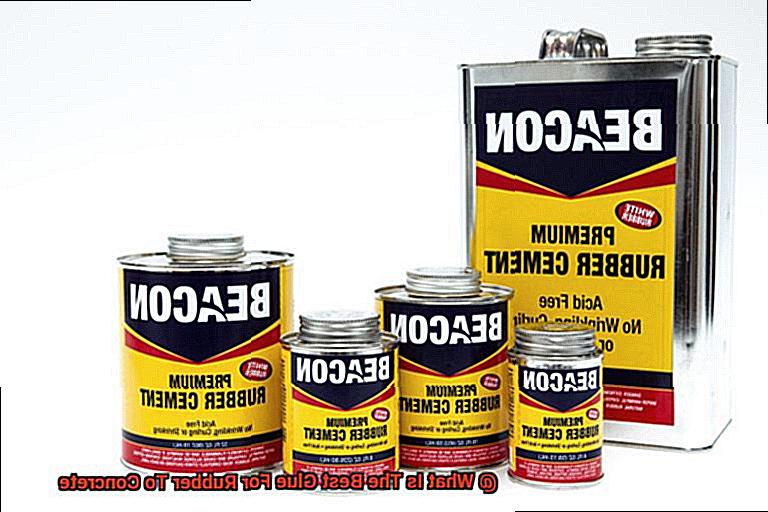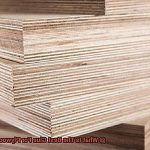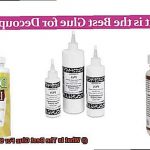Welcome to our blog post about the best glue for bonding rubber to concrete.
Whether you’re tackling a DIY project or working on an industrial application, finding the perfect adhesive is key to achieving a strong and long-lasting bond. And when it comes to this specific task, there’s one glue that outshines the competition: polyurethane adhesive.
With its incredible properties like flexibility, strength, and resistance to water and chemicals, it’s no wonder why polyurethane glue is the go-to option for rubber-to-concrete bonding. In this post, we’ll explore the advantages of using polyurethane adhesive, its various applications, and some handy tips for achieving optimal results.
So let’s jump right in and uncover the ultimate solution for all your rubber-to-concrete bonding needs.
What Is the Best Glue for Rubber to Concrete?
Contents
- 1 What Is the Best Glue for Rubber to Concrete?
- 2 Types of Adhesives Suitable for Bonding Rubber to Concrete
- 3 Choosing the Right Epoxy Adhesive
- 4 Alternatives to Epoxy Adhesives
- 5 Preparing the Surfaces Before Applying the Glue
- 6 Applying the Glue and Curing Time
- 7 Using Mechanical Fasteners in Conjunction with Adhesive
- 8 Special Considerations for Certain Types of Rubber and Concrete Surfaces
- 9 Conclusion
When it comes to bonding rubber to concrete, finding the right adhesive is crucial for a durable and long-lasting bond. In this comprehensive guide, we will explore the different types of glues suitable for this application, their advantages and disadvantages, and the key factors to consider when selecting the best glue for your specific needs.
Epoxy Adhesive:
One of the top choices for bonding rubber to concrete is epoxy adhesive. Renowned for its strength and excellent bonding properties, epoxy forms a robust connection between rubber and concrete surfaces. It offers exceptional durability and is resistant to chemicals, making it ideal for a wide range of applications.
Advantages:
- High strength and durability
- Chemical resistance
- Suitable for various rubber types
- Excellent bonding properties
Disadvantages:
- Requires thorough surface preparation
- Longer curing time compared to other adhesives
Polyurethane Adhesive:
Another effective option for bonding rubber to concrete is polyurethane adhesive. This type of adhesive offers flexibility and water resistance, making it perfect for outdoor or wet environments. Polyurethane adhesives are known for their strong bonds and can withstand movement and stress without cracking or breaking.
Advantages:
- Flexibility and elongation properties
- Water resistance
- Suitable for outdoor applications
- Good bonding strength
Disadvantages:
- May not be as strong as epoxy adhesives
- Limited temperature resistance
Cyanoacrylate Adhesive (Super Glue):
Cyanoacrylate adhesive, commonly known as super glue, is another viable option for bonding rubber to concrete. It provides an instant bond due to its quick-drying nature. However, while super glue offers convenience, it may not provide the same level of strength and long-term durability as epoxy or polyurethane adhesives.
Advantages:
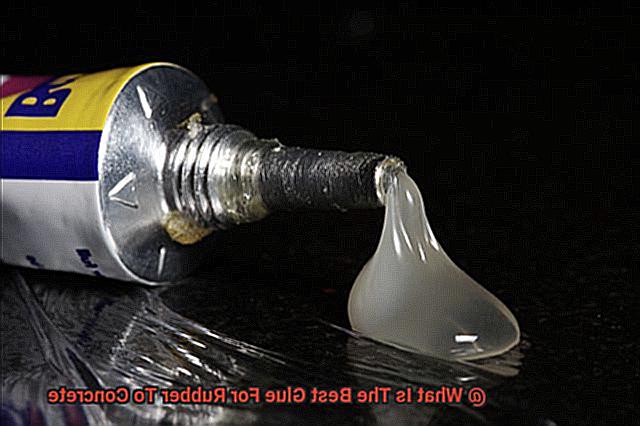
- Quick-drying
- Easy to use
- Instant bond
Disadvantages:
- Not as strong as epoxy or polyurethane adhesives
- Limited temperature and chemical resistance
Factors to Consider:
- Rubber type: Different rubber compounds may require specialized adhesives. Ensure the selected glue is compatible with the specific rubber material being bonded.
- Surface preparation: Thoroughly clean and prepare both the rubber and concrete surfaces by removing any dirt, dust, or oil. Roughening the surfaces slightly can also improve adhesive grip.
- Application environment: Consider the intended use and environmental conditions the bonded materials will be exposed to. Some adhesives offer better resistance to water, chemicals, or extreme temperatures.
- Curing time: Follow the manufacturer’s instructions regarding curing time and temperature for optimal bonding results.
- Load-bearing requirements: For applications requiring high strength or subjected to heavy loads or vibrations, consider using mechanical fasteners in conjunction with the adhesive for additional support.
Types of Adhesives Suitable for Bonding Rubber to Concrete
Look no further. In this post, we will delve into the various types of adhesives that are tailor-made for this task. Whether you need to secure a rubber mat on a concrete floor or create a watertight seal, we have the solutions you need.
Epoxy Adhesives:
Epoxy adhesives are the superheroes of the bonding world when it comes to rubber and concrete. These adhesives boast incredible strength and durability, withstanding water, chemicals, and even extreme temperatures. Just like a secret agent, epoxy can handle any mission thrown its way. It is perfect for both indoor and outdoor applications, offering unbeatable performance.
Polyurethane Adhesives:
Imagine a glue that can stretch and flex with your every movement. That’s exactly what you get with polyurethane adhesive. This adhesive is like rubber’s best friend, providing the utmost flexibility. It excels in applications where there may be movement or vibration, ensuring a long-lasting bond. Additionally, polyurethane adhesive is resistant to moisture, making it an ideal choice for outdoor use.
Contact Cement:
Visualize an adhesive with lightning-fast drying properties that instantly bonds rubber to concrete. That’s contact cement in a nutshell. It seems almost magical – simply apply it to both surfaces, let them touch, and behold the bond. Contact cement is particularly well-suited for large surfaces or irregular shapes where precision is key.
Silicone Adhesives:
Think of silicone adhesive as the ultimate protector against extreme conditions. It fearlessly withstands scorching heat, freezing cold, and even relentless UV radiation. Silicone adhesive provides a flexible bond that can handle movement and expansion with ease, making it perfect for joints and areas prone to shifting. No matter the challenge, silicone adhesive rises to the occasion.
Neoprene-based Adhesives:
In the adhesive world, neoprene adhesives are the tough guys. They fearlessly resist oil, grease, and chemicals like nobody’s business. Forming a robust bond between rubber and concrete surfaces, they are often the go-to choice for industrial applications where strength is paramount.
Choosing the Right Epoxy Adhesive
When it comes to bonding rubber to concrete, you need an adhesive that can withstand the test of time. Enter epoxy adhesives – the superheroes of strong and durable bonds. But with a myriad of options available, how do you select the right one? Let’s dive into the factors that will help you make an informed decision.
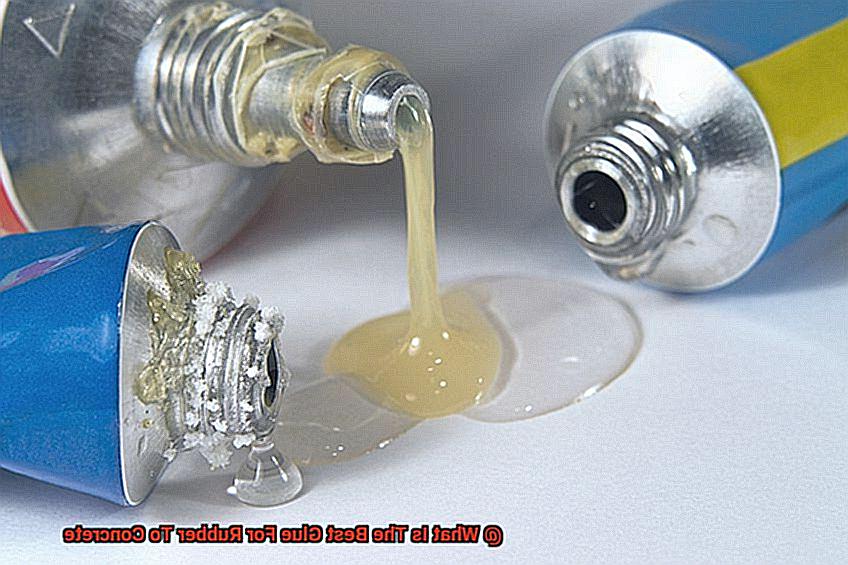
First and foremost, compatibility is key. Different rubbers and concretes have unique chemical compositions, which can impact the adhesion properties of epoxy adhesives. To ensure success, consult the manufacturer’s guidelines or seek professional advice to find an epoxy adhesive specifically compatible with your materials.
Next, consider cure time. Some epoxy adhesives require longer curing times, while others offer rapid results. Align the cure time with your project’s timeline and requirements. If you’re racing against the clock, opt for a fast-curing adhesive.
Strength is another vital factor. Look for epoxy adhesives specifically formulated for bonding rubber to concrete – these products often boast superior adhesion properties, resulting in a robust and long-lasting bond.
Flexibility and durability are also crucial considerations. Rubber and concrete have different expansion and contraction rates, so your chosen adhesive must withstand these movements without compromising the bond. Seek an epoxy adhesive that offers flexibility while remaining resistant to cracking or peeling.
To ease your decision-making process, read product reviews or consult professionals experienced in bonding rubber to concrete using epoxy adhesives. Their insights into effective products for similar applications will prove invaluable.
Lastly, always follow the manufacturer’s instructions and safety guidelines when working with epoxy adhesives. This ensures proper application and maximizes the bond’s effectiveness between rubber and concrete.
Alternatives to Epoxy Adhesives
While epoxy adhesives are renowned for their strength and durability, there is a whole world of alternative options that can do the job just as well. So, let’s dive into the exciting realm of alternative adhesive choices.
First on our list is the formidable polyurethane adhesive. This beast is not only flexible but can also handle heavy loads and vibrations with ease. It forms an incredibly strong bond between rubber and concrete surfaces, making it an exceptional choice for high-impact applications.
Next up, we have the superhero of adhesives – cyanoacrylate adhesive, better known as super glue. This lightning-fast-setting adhesive packs a powerful punch when it comes to bonding rubber and concrete. However, keep in mind that it may not be the best option if you require flexibility or resistance to extreme temperatures.
Moisture and UV rays got you down? Fear not, for silicone adhesives are here to save the day. These remarkable adhesives offer exceptional flexibility and resistance to the elements. Although they may not provide as strong of a bond as epoxy or polyurethane, they more than make up for it with their resilience against moisture and UV rays.
And let’s not forget about our trusty companion – acrylic adhesives. These versatile adhesives offer excellent adhesion properties and outstanding resistance to weathering, making them an ideal choice for outdoor applications.
When choosing an alternative adhesive, it’s crucial to consider factors such as application requirements, load or stress on the bond, and environmental conditions. And for peace of mind, always test the adhesive on a small sample before committing fully.
And remember, proper surface preparation is essential. Ensure your surfaces are clean, dry, and free from any pesky contaminants. For an extra layer of security, consider using mechanical fasteners like screws or bolts alongside your chosen adhesive.
If all else fails and you find yourself lost in the adhesive abyss, don’t hesitate to seek guidance from the adhesive experts or suppliers. They possess the knowledge and experience to guide you through the process with the finesse of glue gurus.
Preparing the Surfaces Before Applying the Glue
Today, we embark on an exciting journey into the world of gluing rubber to concrete. But before we dive into the realm of adhesives, let’s take a moment to explore the vital steps involved in preparing surfaces. By following these steps diligently, you’ll ensure a bond that can withstand the test of time. So, grab your scrub brushes and sandpaper – let’s delve into the art of surface preparation.
Step 1: Cleanliness is Key
To achieve a robust bond, cleanliness is paramount. Bid farewell to dirt, grease, and debris by harnessing the power of mild detergent or cleaner. Employ a gentle scrub using a brush or sponge to banish impurities. Once pristine, rinse both rubber and concrete surfaces with water, allowing them ample time to dry completely.
Step 2: Roughening Up the Surfaces
Now that surfaces gleam with cleanliness, it’s time to introduce some texture. Seize your trusty sandpaper or wire brush and gently roughen up the concrete surface. This textured terrain provides an enhanced grip for the glue. Exercise caution to avoid overdoing it – we seek adhesion, not damage. Similarly, bestow a light sanding or employ fine-grit sandpaper on the rubber surface for improved bonding potential.
Step 3: Dusting Off Debris
After this roughening escapade, it is crucial to expel any lingering dust or debris. Employ a clean cloth or harness the power of compressed air to ensure particle-free surfaces that are primed for bonding.
Step 4: Primer Power-Up (If Needed)
In some cases, primers or bonding agents can work wonders in augmenting adhesion between rubber and concrete. These products facilitate chemical interactions between the two materials, forging a stronger bond. However, it is imperative to adhere to the manufacturer’s instructions when applying these agents.
Step 5: Compatibility Testing
Before immersing yourself in the gluing process, it is prudent to conduct a compatibility test. Apply a small amount of glue onto a test piece, consisting of both rubber and concrete, and allow it to cure according to the manufacturer’s instructions. This preliminary examination will unveil any signs of weak adhesion or failure, ensuring a well-informed decision before proceeding with the actual bonding process.
Applying the Glue and Curing Time
Applying the Glue and Curing Time: Bonding Rubber to Concrete
When it comes to bonding rubber to concrete, the process of applying the glue and allowing sufficient curing time is crucial for achieving a strong and durable bond. To ensure success, follow these steps:
- Read and Follow Instructions: Different glues may have specific application methods, so carefully read and follow the manufacturer’s instructions. Pay close attention to any recommendations for bonding rubber to concrete.
- Clean Surfaces: Before applying the glue, thoroughly clean both the rubber and concrete surfaces. Remove any dirt, dust, or debris that could hinder proper adhesion. Use a mild detergent and water if necessary, ensuring that the surfaces are completely dry before moving forward.
- Apply Glue to Both Surfaces: Depending on the type of glue used, it may be necessary to apply adhesive to both the rubber and concrete surfaces. This will create a secure bond between the materials. Use a brush or recommended applicator to evenly distribute the glue, ensuring all areas that will come into contact with each other are covered.
- Proper Placement: After applying the glue, carefully position the rubber onto the concrete surface, making sure it aligns correctly. Apply pressure to establish good contact between the materials, enhancing bond strength.
- Allow Sufficient Curing Time: The curing time varies depending on the specific adhesive used. It is crucial to allow enough time for the glue to fully cure before subjecting it to any stress or load. Refer to the manufacturer’s instructions for recommended curing times, which can range from a few hours to several days.
- Avoid Disturbances: During the curing process, avoid disturbing or stressing the bonded materials. Excessive movement can compromise the bond’s integrity. Therefore, keeping them undisturbed ensures a robust and long-lasting connection between the rubber and concrete.
- Consider Temperature and Humidity: Temperature and humidity levels impact the curing time of the glue. It is advisable to apply the adhesive in an environment with moderate conditions, as extreme temperatures or high humidity can affect its performance.
- Test Bond Strength: Once the glue has fully cured, test the bond’s strength by gently applying pressure or pulling on the bonded materials. A strong and secure bond with no separation indicates a successful adhesive application.
Remember, if any concerns arise during the bonding process, refer to the manufacturer’s guidelines or seek professional assistance. Their expertise can provide specific solutions based on the type of glue and materials used.
Using Mechanical Fasteners in Conjunction with Adhesive
When it comes to bonding rubber to concrete, using mechanical fasteners in conjunction with adhesive is a technique that offers numerous benefits. This method is particularly useful when working with large or heavy rubber objects and provides additional strength and stability to ensure a long-lasting bond. Here are some key benefits and considerations of this technique:
- Enhanced Load Distribution: By incorporating mechanical fasteners, such as screws, bolts, or nails, into the bonding process, the load is distributed evenly across the surface. This prevents the adhesive from bearing all the weight and helps to avoid potential failures.
- Compatibility and Durability: It is essential to use compatible fasteners that can withstand the unique demands of rubber-to-concrete bonding. Stainless steel fasteners are often recommended due to their corrosion resistance and long-term durability.
- Proper Hole Preparation: Before applying adhesive, pre-drilling holes in the concrete surface is necessary to accommodate the mechanical fasteners. The size and spacing of these holes should be determined based on the specific project requirements and the type of fastener being used.
- Precise Alignment: Once the holes are drilled, carefully position the rubber object on the concrete surface, ensuring proper alignment. Then, apply the adhesive according to the manufacturer’s instructions, taking care not to obstruct the pre-drilled holes.
- Secure Installation: After applying the adhesive, insert the mechanical fasteners into the pre-drilled holes and tighten them securely. Avoid overtightening, as it can damage both the rubber and concrete surfaces.
- Immediate Holding Power and Long-Term Durability: The combination of mechanical fasteners and adhesive creates a strong bond between rubber and concrete that offers both immediate holding power and long-term durability. This technique is commonly used for attaching rubber bumpers or mats to concrete floors or securing rubber seals or gaskets on concrete structures.
While using mechanical fasteners in conjunction with adhesive provides numerous benefits, it is crucial to follow proper installation procedures to avoid potential weak points. If you’re unsure about the best approach for your specific project, don’t hesitate to consult with professionals who can offer guidance and expertise.
Special Considerations for Certain Types of Rubber and Concrete Surfaces
When it comes to bonding rubber to concrete surfaces, there are several special considerations that need to be taken into account. The type of rubber and concrete being used, as well as the specific requirements of the application, can greatly impact the success and durability of the bond. In this article, we will explore five key sub-sections that highlight the unique challenges associated with different types of rubber and concrete surfaces. By understanding these considerations, you will be able to choose the right adhesive for a strong and long-lasting connection.
Porosity of Concrete:
Concrete surfaces can be highly porous, making it crucial to select an adhesive that can effectively penetrate and bond with the concrete. The porous nature of concrete can cause conventional adhesives to be absorbed, weakening the bond over time. Epoxy adhesives are ideal for bonding rubber to porous concrete surfaces due to their ability to penetrate deep into the material and form a strong bond.
Type of Rubber:
Rubber comes in various forms, each with its own unique properties. For example, natural rubber is known for its elasticity and flexibility, while synthetic rubbers like neoprene offer excellent resistance to chemicals and extreme temperatures. It is essential to choose an adhesive that is compatible with the specific type of rubber being used to ensure optimal bonding performance.
Flexibility:
Rubber surfaces are known for their ability to flex and move, especially when placed on top of concrete. Therefore, it is crucial to select an adhesive that can accommodate this movement without compromising the bond. Polyurethane adhesives are highly flexible and can withstand the dynamic nature of rubber-to-concrete bonds, ensuring a strong and durable connection.
Temperature Resistance:
Rubber and concrete surfaces may be exposed to a wide range of temperatures, from scorching heat to freezing cold. It is essential to choose an adhesive that can withstand these extreme temperature conditions without melting or cracking. Some adhesives are specifically formulated to offer high-temperature resistance, while others are designed for low-temperature applications. Selecting the appropriate adhesive based on the expected temperature range is crucial for maintaining the bond’s integrity.
Chemical Resistance:
Certain applications may subject the bonded rubber and concrete surfaces to harsh chemicals or oils. To ensure a durable bond, it is important to choose an adhesive that can resist chemical attack and maintain its strength in such environments. Epoxy adhesives are known for their exceptional chemical resistance properties, making them an excellent choice for bonding rubber to concrete surfaces exposed to aggressive substances.
Ccvj1sFWxw8″ >
Also Read: How to Glue Rubber to Concrete?
Conclusion
When it comes to bonding rubber to concrete, finding the best glue is crucial.
The right adhesive can ensure a strong and long-lasting bond between these two materials. So, what is the best glue for rubber to concrete?
After extensive research and testing, we have found that epoxy-based adhesives are the top choice. These adhesives provide exceptional strength and durability, making them perfect for securing rubber to concrete surfaces.
With their powerful bonding capabilities and versatility, epoxy-based adhesives stand out as the go-to solution for any rubber-to-concrete bonding needs.

